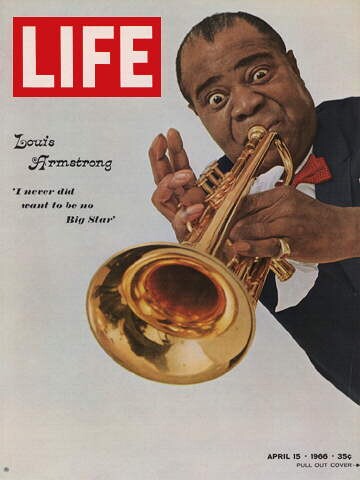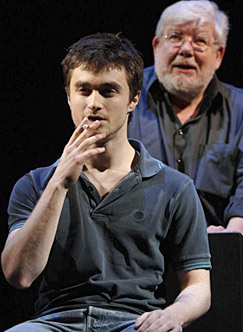• O happy (yet ominously overcast Gothic) day! From Galleycat, news of Donna Tartt’s third novel.
• The correspondence of Elizabeth Bishop and Robert Lowell makes clear how the poets “developed in tandem”: Editing, inspiring, cold-mugging one another.
• A tour of entrepreneur Jay Walker’s incredible personal library. (Via Gwenda.)
Archives for October 2, 2008
TT: Wrapping it up
I got a bit ahead of myself when I declared at the beginning of September that I’d just put “one last coat of polish on the manuscript” of my Louis Armstrong biography. In fact I ended up doing another month’s worth of work on the book, in part because the jazz critic Dan Morgenstern, who knew Armstrong and was kind enough to read the previous draft, sent me a batch of additional notes on the last few chapters. That gave me an excuse to do some further polishing, in the course of which I unearthed more source material…and so on and so forth, ad infinitum. Of the making of books there is no end, saith the Preacher, and he sure knew what he was talking about.
But all things, even the writing of a primary-source biography, must come to an end, and the writing of this book ended on Tuesday night after Mrs. T, who read the manuscript over the weekend, gave me the last of her editorial suggestions, which I hastened to adopt. I read through the whole book from start to finish, and at long last I heard the click in my mind’s ear that told me to lay down my blue pencil. It’s finished, I said to myself, and I could feel my body slackening with relief as I said it.
 On Wednesday morning I e-mailed Andrea Schulz, my editor at Harcourt, to let her know that I was ready to discuss the placement in the text of the “images” of Armstrong (as they’re now known in the book trade) that will be included in the published version. She’d already commented in detail on what turned out to be the antepenultimate draft, so the next thing I did was e-mail her the complete finished manuscript. No fanfare, no fuss: I clicked a few keys and off it went, and that was that.
On Wednesday morning I e-mailed Andrea Schulz, my editor at Harcourt, to let her know that I was ready to discuss the placement in the text of the “images” of Armstrong (as they’re now known in the book trade) that will be included in the published version. She’d already commented in detail on what turned out to be the antepenultimate draft, so the next thing I did was e-mail her the complete finished manuscript. No fanfare, no fuss: I clicked a few keys and off it went, and that was that.
Andrea had already told me that the sales force at Harcourt was lukewarm about “Rhythm Man” as a title, so I went back to the drawing board. Alas, I was getting nowhere fast when she sent me another e-mail in which she mentioned a description by the trumpeter Rex Stewart of a performance given by Armstrong in the early Thirties:
Louis bounced onto the opposite stage, immaculate in a white suit. Somehow, the way the lights reflected off his trumpet made the instrument look like anything but a horn. It looked as if he were holding a wand of rainbows or a cluster of sunlight.
“Might there be a title there?” she said. “It has a poetic ring to it.”
I riffled through the prologue of the book, in which Andrea had found Stewart’s description, and ran across the following passage:
The trumpeter Max Kaminsky told of how “the combination of Louis’s dazzling virtuosity and sensational brilliance of tone so overwhelmed me that I felt as if I had stared into the sun’s eye.” Such imagery came easily to those who heard Armstrong in his halcyon days. The poet Philip Larkin, a part-time jazz critic and lifelong fan, praised him in similar terms, calling him “something inexhaustible and unchanging like the sun.”
A Cluster of Sunlight: The Life of Louis Armstrong, I thought. Not too shabby.
Mrs. T agreed, as did Dan Morgenstern. I Googled the phrase and found it to be unique to Stewart. It looked nice when I dummied up a new title page, and it still looks nice a month later. So that’s the new title of my book, and unlike the last one, I think it’s going to stick.
Now I’m finished with research, finished with tinkering, ready to put A Cluster of Sunlight aside. As of now, anything I don’t already know about the life and work of Louis Armstrong isn’t worth knowing, at least as far as I’m concerned. Much, to be sure, remains to be done before the book goes to press a year from now. I still have to pick the images, write the captions, answer the copyeditor’s queries, fill out the publicity questionnaire, sign off on the design, edit the galleys, approve the flap copy, and write a stump speech. But the hard part is really and truly over, and though that fact has yet to soak in, I expect that it’ll hit me like a tidal wave at some point in the next week or two.
At which point…what? Post-partum depression, more than likely. Or maybe not. After all, I’ve still got an opera to finish, not to mention my usual full plate of theater-related work. And the exhilaration that goes along with wrapping up a large-scale project takes a fair amount of time to dissipate.
As I wrote in this space four and a half years ago:
Three months ago, All in the Dances didn’t exist. Over the years I’d told dozens of people all about George Balanchine’s life and work, but every time I had to start fresh. Now there’s an inch-thick pile of paper on my kitchen table with a title page on top, the gateway to a world I made, and even though I’ll be reviewing a Broadway play tomorrow morning, then writing my Washington Post column in the afternoon, part of me is still back in that world of shadows.
That’s why I wanted to tell you now about how it felt–and how it feels. I want to enjoy it just a little while longer before I return to the world of daylight and deadlines.
I feel that way today, and I expect I’ll feel the same way tomorrow. This is the longest and most ambitious book I’ve written, and I think it’s worthy of the great and good man who is its subject. In the end, of course, that will be for others to say, not me, but so far they haven’t read it. As of this morning, only seven living people have read A Cluster of Sunlight, and I’m one of them. The other six claim to like it as much as I do.
The rest of the world can wait: today I’m content.
TT: So you want to see a show?
Here’s my list of recommended Broadway, off-Broadway, and out-of-town shows, updated weekly. In all cases, I gave these shows favorable reviews (if sometimes qualifiedly so) in The Wall Street Journal when they opened. For more information, click on the title.
Warning: Broadway shows marked with an asterisk were sold out, or nearly so, last week.
BROADWAY:
• Alfred Hitchcock’s The 39 Steps (comedy, G, suitable for bright children, reviewed here)
• August: Osage County (drama, R, adult subject matter, reviewed here)
• Avenue Q (musical, R, adult subject matter and one show-stopping scene of puppet-on-puppet sex, reviewed here)
• Boeing-Boeing (comedy, PG-13, cartoonishly sexy, reviewed here)
 • Equus (drama, R, nudity and adult subject matter, reviewed here)
• Equus (drama, R, nudity and adult subject matter, reviewed here)
• Gypsy (musical, PG-13, adult subject matter, reviewed here)
• The Little Mermaid * (musical, G, entirely suitable for children, reviewed here)
• South Pacific * (musical, G/PG-13, some sexual content, brilliantly staged but unsuitable for viewers acutely allergic to preachiness, reviewed here)
OFF BROADWAY:
• Enter Laughing (musical, PG-13, extended through Oct. 26, reviewed here)
• The Fantasticks (musical, G, suitable for children capable of enjoying a love story, reviewed here)
CLOSING SOON IN CAPE MAY, N.J.:
• To the Ladies (comedy, G, closes Oct. 18, reviewed here)
CLOSING SUNDAY IN HARTFORD, CONN.:
• A Midsummer Night’s Dream (comedy, G, surprisingly child-friendly, closes Oct. 5, reviewed here)
CLOSING SUNDAY IN MADISON, N.J..:
• A Streetcar Named Desire (drama, PG-13, adult subject matter, closes Oct. 5, reviewed here)
CLOSING SUNDAY IN SPRING GREEN, WISC.:
• A Midsummer Night’s Dream/Widowers’ Houses (comedies, G, playing in repertory through Oct. 5, reviewed here)
TT: Almanac
“Pain itself can be pleasurable accidentally in so far as it is accompanied by wonder, as in stage-plays; or in so far as it recalls a beloved object to one’s memory, and makes one feel one’s love for the thing, whose absence gives us pain. Consequently, since love is pleasant, both pain and whatever else results from love, in so far as they remind us of our love, are pleasant.”
St. Thomas Aquinas, Summa Theologica
